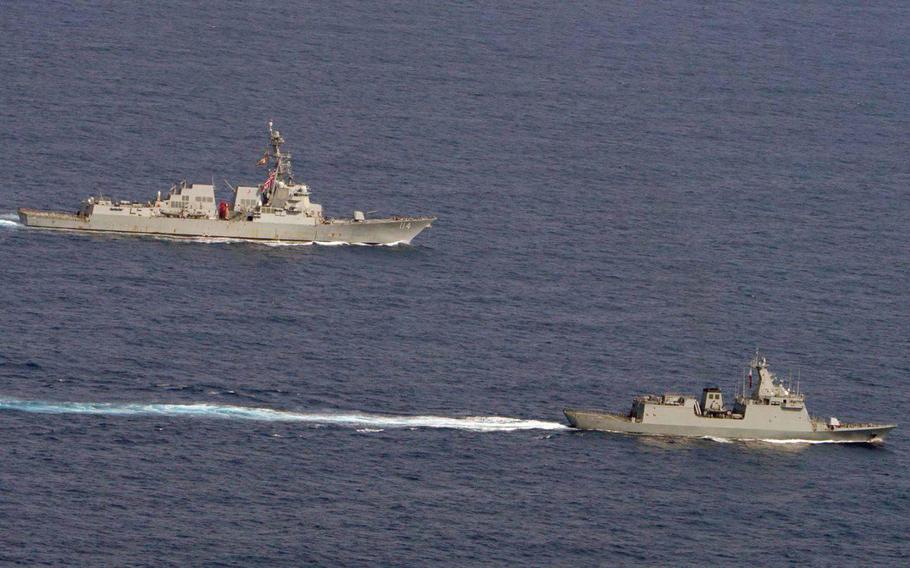
The guided-missile destroyers USS Ralph Johnson and BRP Jose Rizal steam through the South China Sea during a joint exercise, Monday, Sept. 4, 2023. (Philippine armed forces)
Guided-missile destroyers from the U.S. and Philippine navies recently carried out “close proximity” maneuvering drills near a contested island chain in the South China Sea, according to both services.
The USS Ralph Johnson joined the BRP Jose Rizal on Monday for “division tactics” training to help build “the confidence of the bridge teams to manage more challenging sailing conditions,” the U.S. 7th Fleet said in a same-day news release.
The training took place west of Palawan, a Philippine island approximately 170 miles southwest of Manila and 195 miles east of the contested Spratly Islands, the Armed Forces of the Philippines said in a Monday news release.
The exercise allowed the allied navies to “test and refine existing maritime doctrine and demonstrate their defense capabilities in line with the shared commitment of upholding peace and security in the Indo-Pacific Region,” according to the Philippine release.
The Philippines led the exercise, according to a Tuesday email from 7th Fleet spokeswoman Cmdr. Megan Greene, who referred all questions to that country’s armed forces. They did not respond Tuesday to an emailed request for further comment.
A dispute between China and the Philippines over the Spratlys, an archipelago of more than 100 small islands and reefs, is becoming heated. The entire chain is claimed by China, Vietnam and Taiwan; portions are claimed by the Philippines, Malaysia and Brunei.
About 45 islands in the Spratlys are occupied by small military outposts from China, Malaysia, the Philippines, Taiwan and Vietnam.
The Philippines has garrisoned Second Thomas Shoal, where the deliberately grounded World War II-era ship BRP Sierra Madre has become a flashpoint between Beijing and Manila.
On Aug. 5, Chinese coast guard vessels temporarily delayed resupply of the Philippine troops at the shoal by blocking the path of chartered supply vessels and Philippine coast guard escorts. One Chinese vessel used a high-powered water cannon on one of the supply ships.
The Philippine coast guard at the time called on Beijing to “restrain its forces.”
U.S. Defense Secretary Lloyd Austin said China’s actions undermined the status quo and “directly threaten regional peace and stability.”
State Department spokesman Matthew Miller, in an Aug. 5 statement, reaffirmed that an armed attack on Philippine vessels would trigger the U.S.-Philippines Mutual Defense Treaty.
Second Thomas Shoal will likely remain a point of contention between the two countries, largely due to the presence of the Sierra Madre, according to Carlyle Thayer, an emeritus professor at the University of New South Wales and a lecturer at the Australian Defence Force Academy.
China has repeatedly demanded the removal of the Sierra Madre, he told Stars and Stripes in an Aug. 9 email. “China invariably responds when the Philippines tries to reprovision the soldiers at Second Thomas Shoal.”
The Philippines grounded the Sierra Madre on the shoal in 1999 as a response to China’s occupation of Mischief Reef in 1995, he said, and a “strategic move to pre-empt further occupation in the West Philippine Sea.” The two features are approximately 21 miles apart.